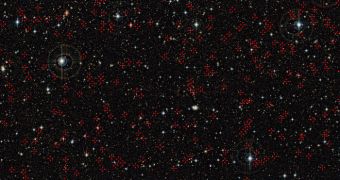By combining data from two advanced telescopes, a team of astronomers was recently able to get a better understanding of how supermassive black holes were turned on in the early days of the Universe.
The research covered the last 11 billion years of the Universe' 13.75 billion years. The first dark behemoths began developing about two and half billion years after the Big Bang exploded everything into being.
In order to conduct the new research, the team used data collected by the European Southern Observatory's (ESO) Very Large Telescope (VLA) and the XMM-Newton X-ray space observatory, which is managed by the European Space Agency (ESA).
The most interesting discovery made by the two telescopes baffled astronomers – the data appear to indicate that galactic mergers taking place in the early Universe were not responsible for turning on supermassive black holes, as past studies had suggested.
Throughout the Universe, astrophysicists identified two main types of large black holes – the quite ones, such as the object at the core of the Milky Way, and the highly-active ones, that consume material in their surrounding, releasing massive amounts of radiation.
What experts are trying to determine is where the material that feeds active black holes comes from. One theory is that galactic mergers billions of years ago stirred the gas clouds inside galaxies, herding them towards standard black holes, and turning them on.
But the new study indicates that this mechanism may not explain the situation of many active galaxies researchers are seeing today. The new investigation was led by expert Viola Allevato, from the Max Planck Institut für Plasmaphysik's Excellence Cluster Universe, in Garching, Germany.
Researchers with the international COSMOS collaboration were also involved in the study, which covered more than 600 active galaxies from the so-called COSMOS field. Details of the research effort will appear in the upcoming issue of the esteemed Astrophysical Journal.
Of the galaxies the team surveyed, only a few had extremely brilliant active nuclei, while the rest were only moderately bright. In most cases, galactic mergers were not observe, so as to support the previous theory.
“It took more than five years, but we were able to provide one of the largest and most complete inventories of active galaxies in the X-ray sky,” study author Marcella Brusa explains. She is based at the Max Planck Institute for Extraterrestrial Physics [MPE], in Garching, Germany.
“These new results give us a new insight into how supermassive black holes start their meals. They indicate that black holes are usually fed by processes within the galaxy itself, such as disc instabilities and starbursts, as opposed to galaxy collisions,” adds Viola Allevato.
Allevato, the lead author of the Astrophysical Journal paper, is based at the IPP.

 14 DAY TRIAL //
14 DAY TRIAL //